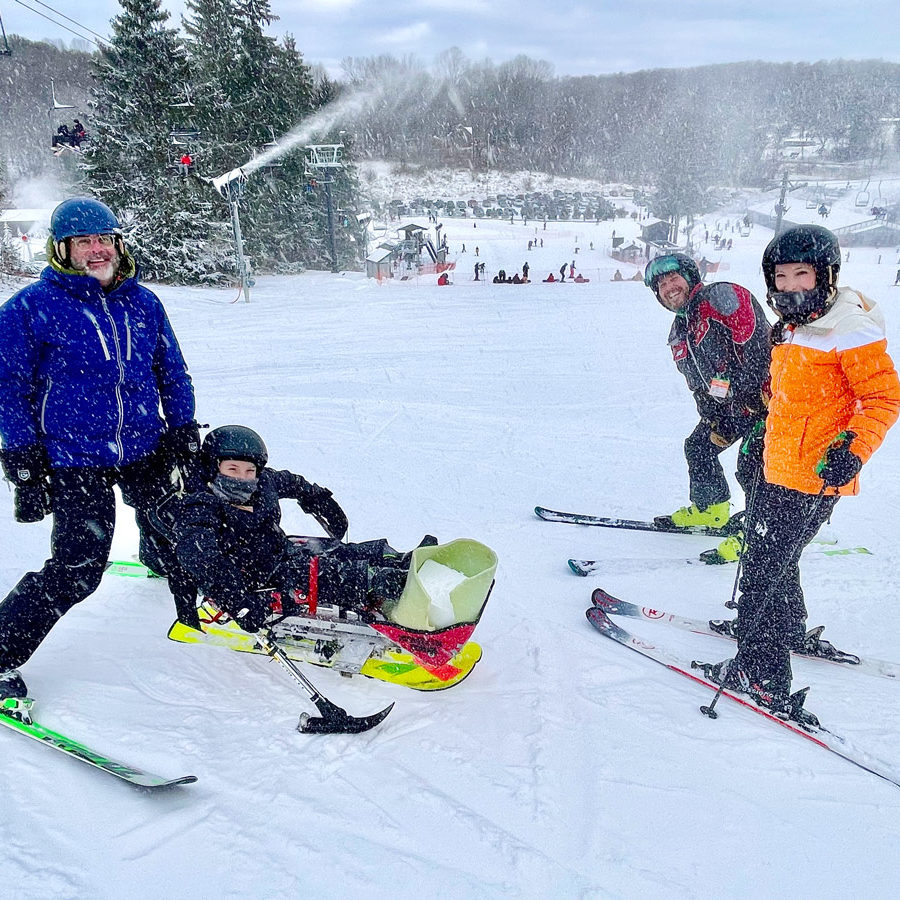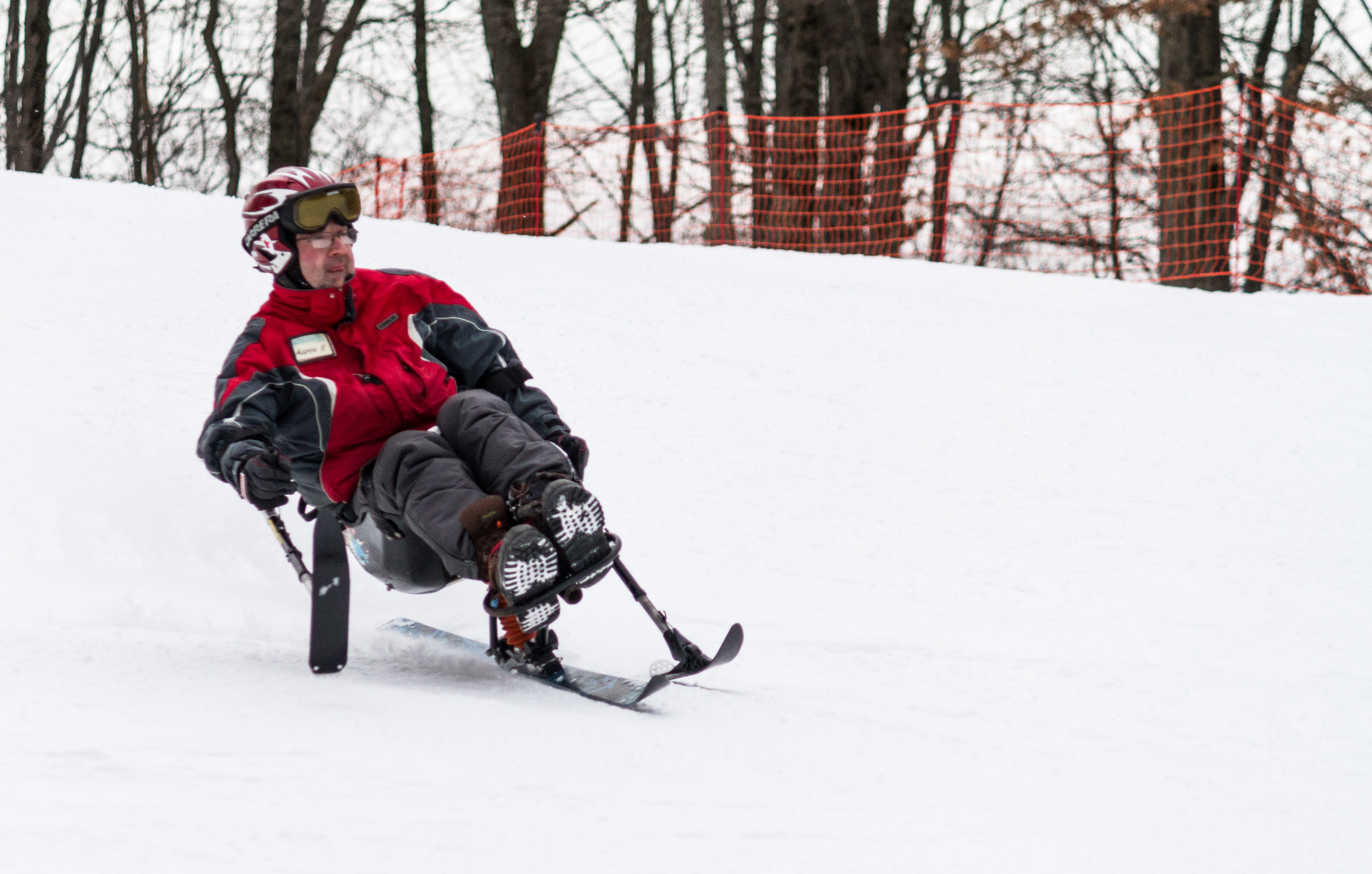Imagine the freedom of swooshing down the slopes.
At Adaptive Sports Connection, our certified professional ski instructors will help you experience the rush of downhill skiing. Our programs meet the needs of beginners to competitive racers - opening up opportunities to make your dreams a reality.
Adaptive Sports Connection has a wide variety of adaptive equipment for stand up, sit skiers, and snowboarders. Lessons and open skiing are held on Saturdays in January and February at Snow Trails and Mad River Mountain. We make every effort to accommodate groups and families.
Regardless of ability level, each new skier participates in a 2.5-hour session with an instructor to assess your needs, abilities, and goals. Our certified ski instructors are skilled in using various types of adaptive skis, and in teaching specific strategies to meet your needs. Our instructors have assisted at disabled sports ski events in West Virginia, Michigan, Colorado, and New York.
If you have a desire to ski, race, or compete at a regional or national level - our instructors can help make your dreams a reality.
Lesson space fills up quickly, so be sure to register online early!


What to expect:
-
- First and foremost your safety is our top priority - a certified trained ski instructor and/or trained volunteer will ski with athletes - even those at the competition level.
-
- When you arrive at Snow Trails look for the Adaptive Sports Connection building next to the lodge. At Mad River Mountain go to the main building and look for the Adaptive Sports Connection location.
-
- You will then check-in, fill out waiver forms, pay any fees if applicable, and be matched with an instructor/volunteer.
-
- If you are a first time athletes you will go through an initial assessment during which they will ask you about your mobility level, determine range of motion, strength, flexibility, areas of weakness and endurance in order to make sure you have the most appropriate equipment.
-
- Instructors will also work with family members so they can participate with you.
-
- Instructors will set goals for your lesson that match your desires, taking into consideration his/her knowledge about the area and conditions for the day.
-
- If you have participated in the Adaptive Sports Connection ski program before, you will still meet with an instructor to adjust your equipment if needed, and discuss your current goals.
-
- Beginner lessons will start on the flat snow with skills and drills.
-
- All athletes are required to wear a helmet.
-
- Please dress warm and wear layers of non-cotton winter clothes.
-
- Bring a water bottle and sunscreen.
-
- Lessons typically last from 1.5 to 3 hours.
-
- Most of all have fun and unleash your inner athlete!
Methods of Skiing
Depending on your level of disability, there are several ways you can ski using different types of adaptive equipment.
Four-track skiing is an ideal technique for persons with a wide variety of disabilities, including double amputees, spina bifida, cerebral palsy, muscular dystrophy, multiple sclerosis, stroke, head trauma, paraplegia, and polio. An individual who is capable of standing independently or with the aid of outriggers could ski four-track using two skis with two hand-held outriggers for balance/support, giving the skier four points of contact with the snow. Outriggers are metal forearm crutches with ski tips on the ends, some having adjustable brakes to aid with balance if necessary.
In addition to outriggers, ski stabilizers or tip clamps (ski bras) are used for lateral stability if needed. A tip clamp can also allow a student's strong side to help control the weaker side. The design of tip clamps allows the skis to stay in a wedge or parallel position while skiing.
Three-track skiing is stand-up skiing using one full-size ski and two handheld outriggers for balance/support, giving the skier three points of contact with the snow. Individuals with above-knee amputations and single limb weakness typically use this method of skiing. It also can be suitable for those with cerebral palsy, muscular dystrophy, multiple sclerosis, post-polio syndrome, arthritis, spina bifida, spinal cord injury, and traumatic brain injury. Three-track skiing requires strong leg and arm strength, and may not be for those who have weakness in their remaining limbs.
Two-track skiing is suitable for any skier who stands on two skis and does not require outriggers. The skier can stand and maintain balance while in motion, although adaptive equipment (tethers, spacers, ski bras, etc.) may be used to aid in leg strength. Two track skiing is best suited to students with developmental and cognitive disabilities, mild cerebral palsy, visual impairment, hearing impairment, traumatic brain injury, Fragile X Syndrome, epilepsy, Friedreich's Ataxia, Autism Spectrum Disorder, Asperger Syndrome, and spina bifida.
There are many below-knee amputees who can ski using the two-track methods thanks to advancements in prosthetics (carbon fiber, durable systems and sockets, improved suspension) that make it possible. However, not every prosthetic knee can withstand the forces of alpine skiing, so a skier should consult with their prosthetist first to determine the best type of components for their intended activity.

Anyone who cannot ski standing can use a technique called sit-skiing, using a mono-ski or a bi-ski.
Mono-skiing utilizes a bucket style seat with a single ski underneath it. An individual uses handheld outriggers for balance, requiring strong arms and good core strength and trunk balance. Individuals who have lower limb impairments and reasonable trunk stability and balance use mono-skis. Those with brain trauma, post-polio syndrome, muscular dystrophy, cerebral palsy, multiple sclerosis, spina bifida, spinal cord injuries and double amputees are good candidates for mono-skiing.
Bi-skiing utilizes a bucket style seat with two skis underneath it. The bi-ski is designed for those who use a wheelchair or have difficulty walking even when assisted by crutches, canes or walkers. The typical candidate for the bi-ski would be an individual with a mid- to high-level spinal cord injury, cerebral palsy, multiple sclerosis, spina bifida, muscular dystrophy, amputees, or other severe balance impairments.
A bi-ski can be skied independently like a mono-ski using the same type of handheld outriggers or can be skied with the assistance of an instructor using fixed outriggers and tethers (reins attached to the back of the bi-ski). Skiers turn by either moving their head and shoulders or by using handheld outriggers. A bi-ski can be a choice for a new sit-down skier before moving on to the mono-ski, depending on the shared goals of the skier and instructor.

Visual Impairment (VI) is not a barrier to fun on the slopes. Skiers learn to ski with the assistance of a specifically trained guide. For first-time VI skiers, the guide skis first, but facing backwards to the student; students with peripheral vision can be guided from the side. A guide can also call out instructions from behind the skier. The key is for the student and guide to determine the best method of communication before the lessons begin.

